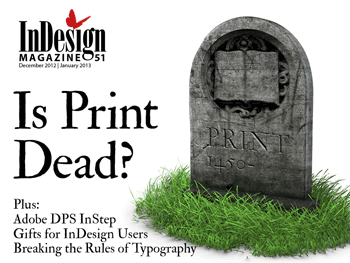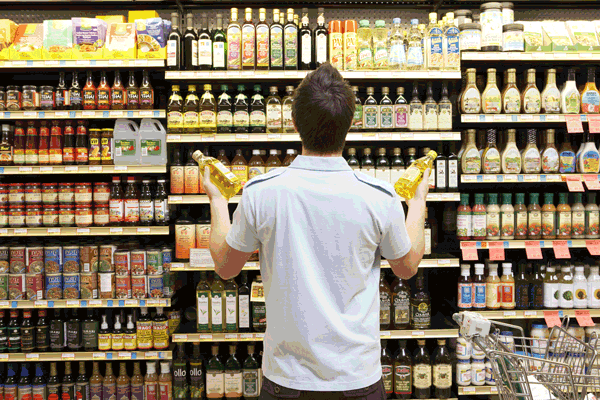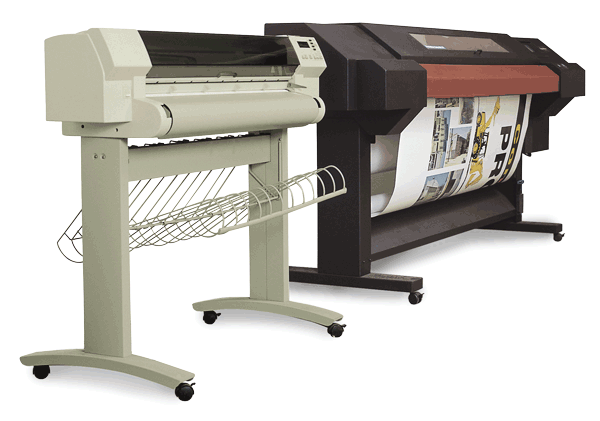Is Print Dead?

This article appears in Issue 51 of InDesign Magazine.
This article was originally published in InDesign Magazine issue 51.

You kids don’t know how good you have it. Why, when I started in printing, we didn’t even have pixels. And then, at first, they only came in eight colors, and weighed about six pounds apiece. Now, like phones, cars, and computers, they’re much smaller. Shoot, you can carry over three million of them around on the iPad with Retina display. No wonder so many publications, newspapers, and books are migrating to tablets. But I know something with an even higher resolution: it’s a little thing called Print.
If you’re a longtime print designer, you may feel a little left out amid all the migration of content to tablet devices and smartphones. With InDesign CS5.5 and CS6 bristling with features devoted to digital publishing, should print designers feel obsolete? Should you abandon your long-held beliefs that everything should be CMYK and 300 ppi? Is all of your work destined to be portrayed only in fleeting pixels, never to feel the caress of coated stock?
The short answer is “no.” In fact, you will be pleasantly surprised to know that many areas of the print world are not diminishing—some are even growing. And, most importantly, there are some methods of communication that can only be accomplished in print.
Obviously, I would encourage every InDesign user to explore the tablet publishing features: the tools are intuitive, the process can be understood by mere mortals, and it’s always a good idea to learn something new. But that said, let’s look at what’s going on in the world of print.
Overview
Looking for some good news? Check out some of the statistics from PrintIsBig.com:
- 45 trillion pages are printed annually. That’s 45 million million pages.
- Profits in the U.S. printing industry were up every quarter in 2010 and 2011.
- Printing within the automotive industry alone amounted to $432 billion.
- While some people complain that printing has an environmental impact, remember that sending (and reading) spam email wastes 33 billion kilowatt-hours annually (equivalent to 3.1 million cars on the road).
- Since 2004, direct mail response rates are up 14%, while email marketing response rates are down 57% (maybe we’re just not falling for those Liberian lottery stories anymore).
- Believe it or not, 96% of news reading is still done using print.
- The average person uses twice as much electricity in powering on a single computer than the energy used in producing all the paper they use in a year.
- Thanks to ecological initiatives, the print industry is actually one of the most sustainable industries. The Forest Stewardship Council has had a positive impact on forestry and paper manufacturing, and designers now have ample resources for sustainable paper choices from FSC-certified suppliers.
Best of all: Curtis Johnson, National Account Executive with RR Donnelley, observes that he’s seeing growth in flexography, flexible packaging, food and pharmaceutical packaging, and as well as combination packaging (for example, containers that combine paperboard and plastic components, such as blister packs).
According to a source in a major printing company with a large client base of catalog publishers, there is no feeling that digital publications or online resources have cannibalized the printed catalogue. Digital offerings are seen as a necessary complement to printed materials. And while print numbers have gone down, that is seen as a consequence of the economy as a whole. Cataloguers still want to get printed material out there, but are concentrating on targeted marketing instead of just sending seven metric tons of printed material to my mailbox, in the hopes that I will buy, say, a Gold-plated Limited Edition Star Trek Pizza Cutter. Not that I wouldn’t be swayed by that.
The Variety of Print
When you think “print,” what comes to mind? Magazines, books, and newspapers, probably. But print is everywhere. Look around your house: wallpaper, drink bottles, cosmetics, haircare products—all printed. When you shop at a department store, look up to admire the large in-store signs announcing specials. At the grocery store, take a look at the thousands of printed pieces of food packaging, and then glance down for ads applied to the floor. When you pull out your wallet to pay, look at the graphics on your credit card, and don’t forget the business cards you’ve crammed in there, too. On your way home, glance at the billboards along the way. Look down at that hipster t-shirt you’re wearing—it’s probably silk-screened. That’s right—print is inescapable.
Packaging and Labeling

Face it—until we can teleport cereal (or the Star Trek replicator becomes a reality), there will always be packaging. And all those fabulous digital devices we’re buying to view publications? They come in packages, don’t they?
“Packaging and labels for consumer products are a good, stable print market,” says Bob Leahey, associate director at InfoTrends. “It’s a print market where there’s zero electronic displacement, and overall it tends to grow with growth in human population. Globally, it’s also growing with economic development, as young market economies give more people access to packaged goods made with modern manufacturing lines.” Leahey explained that digitally printed labels for fast moving consumer goods (FMCG—yes, there’s an acronym for everything) account for a small but growing share of FMCG labels, and that a much smaller segment of digitally printed folding cartons and flexible packaging is also growing. “Color digital printing is giving converters of labels and packaging a welcome ability to print short runs quickly and conveniently,” Leahey said. “Their brand-owner customers want that flexibility and timeliness in package and label printing, in particular to target markets with more versions of their products.”
Leahey adds that while conventional solid bleached substrate (SBS) cartons and specialty finishing such as embossing, die-cutting and hot-foil work seem to be relatively stable, flexography, corrugated boxes, flexible packaging, and combination packaging markets are growing.
If you’re a print designer looking for a stable market, you might consider entering the world of packaging. It’s much more than
“just boxes.” Packaging runs a lengthy spectrum from bottles, cans, and bags to complicated folding cartons and combination containers with paper and plastic components. An ability to think in three dimensions is definitely a plus—package design is a combination of engineering and art. And think of all the gorgeous cosmetic and perfume packaging you’ve seen; the widespread use of metallic substrates and specialty finishing techniques such as die-cutting, embossing, and foil stamping means that, as a designer, you can have an enormous, fun toolbox to play with.
Label uses are nearly endless, applied to containers as various as wine bottles, boxes, industrial devices, and consumer products. Amy Machado, Senior Research Analyst at International Data Corporation (IDC), points out that “Digital printing of labels and packaging is one of the fastest growing segments in the industry. Digital enables label converters to move short-run jobs from conventional presses with faster turnaround times, while adding variable data. By eliminating plate-making time, converters can reduce labor costs, waste, and inventory.”
Visualizing Packaging

If you’re designing packages in Adobe Illustrator, you might want to check out Esko Studio. It allows you to fold up a package design in a 3D view, and rotate it to preview.

Digital Printing
The move from conventional offset printing to digital printing has been one of the biggest changes in recent years. While early devices were essentially glorified laser printers, digital presses now rival offset quality. Commercial printers are now augmenting their traditional offerings with digital output to garner short-run jobs that would be too expensive for cranking up the big iron. Some are even using digital presses such as the HP Indigo for proofing before running a job on an offset press.
As Amy Machado (IDC) says, “Digital production print is growing. Print quality from many digital devices is on par with traditional offset, and using digital is smart manufacturing because with it comes automation, faster workflows, and targeted short print runs. Commercial print is not dead, but it is changing. Print service providers who succeed will bring end-to-end solutions to their clients, selling marketing services and pushing high-value color pages.”
Large Format

I was pretty excited when I finally got a tabloid inkjet printer… think how happy I’d be if I had a Fuji Uvistar that can print up to 197 inches wide!
Large-format printers are used for sign and banner printing, in-store signs and displays, window graphics, tradeshow banner stands, and more. Want to create your own custom wallpaper or patterned cloth? You actually can, using suppliers such as:
And as Amy Machado points out, “Vendors are continuing to innovate on large format. Latex ink has been a big success for HP, and other vendors are starting to get into that game. Adding Light Black, Orange, White, and Metallic inks improves image quality and opens up more substrate options. HP introduced its latex ink in 2008, and has found great success with it since. Latex is very versatile. It requires no drying time, can print on a variety of substrates, including vinyl, textiles, and uncoated stock. Customers looking for environmentally conscious printing options have really taken to it.”
Vehicle Wraps
The next time you’re stuck in traffic, take a minute to check out the commercial vehicles around you—they’ve become rolling billboards for their companies. Nowadays an old-fashioned hand-lettered sign on the side of a van looks amateurish next to the full-color pictorials adorning company vehicles these days. And if there’s a fender-bender? Just reprint and reinstall—that’s how NASCAR vehicle graphics are repaired after those 10-car pileups.
Understandably, designing for vehicles is an exacting process, taking into consideration all the nooks and crannies of a car, truck, or van. And installing vehicle wraps is a complicated process that makes hanging wallpaper look easy. Watch this time-lapse video of an install:
For vehicle wrap resources and examples, check out:
Unusual Substrates and Applications
Moving beyond paper and vinyl, there are printing methods for many different surfaces. For example, EFI , well-known for front-end systems for many imaging devices, has acquired the Spanish company CretaPrint (www.cretaprint.com), which manufactures printers that can print precision pattern on ceramic tiles.
Combining laser imaging and a versatile printing solution, Russell Brown demonstrated his “Extreme Painting” experiment with blocks of wood during Adobe MAX 2010, using equipment from Universal Laser Systems and Direct Color Systems.
Water Transfer
Water transfer systems make it possible to transfer graphics to highly irregular surfaces, such as automotive and marine parts, bicycle frames, metal furniture, and more. Graphics are printed on a carrier film, which is then floated on the surface of a water tank. A solvent is sprayed over the floating membrane, dissolving the carrier and leaving the graphic pigment floating alone on the surface of the water. The piece to be decorated is then slowly immersed into the pool of pigment, which coats every surface of even complicated shapes. To finish the piece, clear coating is applied, followed by heat curing and drying. One of the common applications of water tra
nsfer printing is for automotive dashboards with textured or woodgrain appearances. Watch this video of the water transfer process, from HG Arts.
Eat Your Mistakes

Now I’m going into slightly silly (but delicious) territory: you can now buy sheets of sugar icing and run them through a variety of suitable inkjet printers loaded with edible food-safe inks, creating photographic cake art. To my delight/horror, I’ve discovered that edible inks are available for my Epson printer, and I am sorely tempted.
If you are also tempted, check out the printers, inks, and edible frosting sheets available at www.kopykake.com. While they sell turnkey solutions, if your Canon or Epson printer is listed, you could be printing cupcakes for Christmas.
What’s Not Growing (and Why)
It’s fairly obvious that much of magazine, newspaper, directory, and book publishing has gravitated to the glowing screens, but what other kinds of publications have gone digital? Interestingly, tablet devices such as the iPad aren’t the only influence, and commercial printing isn’t the only victim. Kodak and Lexmark are closing their consumer inkjet printer manufacturing units because of lack of demand. Other manufacturers, such as Epson, Canon, and HP, have offerings that go beyond the consumer market, serving prosumer and professional photography needs, as well as commercial markets, so they’re not going away.
We may also have smartphones to blame for these developments; with the ability to view photos, email, or Web content on phones, consumers don’t need to print out maps for their dinner outings, nor do they need to carry piles of paper to share baby pictures at that dinner. There’s no escaping some things.
The Final Verdict
So…is print dead? Absolutely not! While online resources, smartphones, and tablets are taking the place of some instances of print, some specialty print market segments are growing, and smart commercial printers are constantly evolving in response to big trends in technology, culture, and commerce. I don’t hear anyone yelling “Stop the presses!”
My thanks to Bob Leahey from InfoTrends, Amy Machado from IDC, and Curtis Johnson from RR Donnelley for their insights into what’s going on in the various segments of the printing industry.
Claudia McCue is the author of Real World Print Production with Adobe Creative Suite Applications (Peachpit Press, 2009) and Fearless Flash: Use Adobe® InDesign® CS5 and the Tools You Already Know to Create Engaging Web Documents (Adobe Press, 2010), a contributor to several other graphics arts books, and the presenter for “Acrobat X: Creating Forms” for Lynda.com. When not chained to the computer, she’s riding her motorcycle on country roads, singing in her helmet. She swears it’s the cure for writer’s block.
After 25+ years in real-world print production, she now teaches creative and production professionals how to use Adobe products without hurting themselves or others.
This article was last modified on January 6, 2023
This article was first published on June 5, 2013




